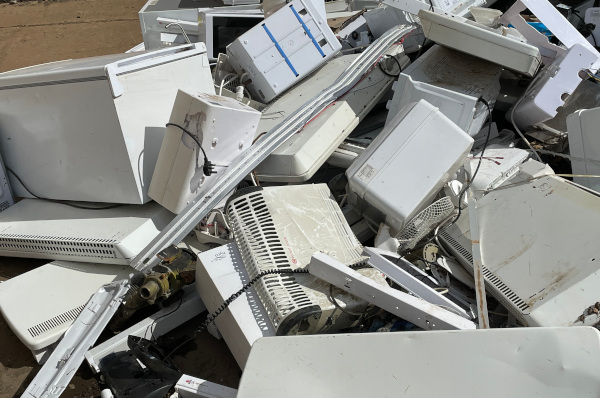Household Waste Electric and Electronic Equipment (WEEE)

What is WEEE?
Household Waste Electric and Electronic Equipment or WEEE includes most products that have a plug or need a battery.
In the UK the Government estimates that households and businesses throw away over 2 million tonnes of electrical waste each year, most of which goes into landfill, without proper treatment.
What household products are included?
Large household appliances, such as ovens, fridges and washing machines, currently make up over 40% of WEEE, but there are large volumes of other equipment. These include IT equipment (mainly computers), TVs (over two million discarded each year), small household appliances (including kettles and hair dryers), electrical tools, digital watches, electronic toys and medical devices.
All of these items contain a wide variety of materials including metal, glass, ceramics and precious metals. For example an average TV contains 6% metal and 50% glass, whereas a cooker is 89% metal and only 6% glass, so many materials can be recovered if processed at an accredited treatment centre.
How can Ward help with household waste?
Ward is very proud to be working alongside approved compliance schemes and original equipment manufacturers to ensure WEEE Regulations are adhered to.
We help our customers to reduce the amount of electrical and electronic waste going to landfill sites and improve recovery and recycling rates of these WEEE products.
Who needs to comply with WEEE regulations for disposing of waste electrical equipment?
If you have waste electrical or electronic equipment, such as old TVs, laps tops, computers, games consoles, hairdryers, toasters or other small electrical items that no longer work or you no longer use, you will almost certainly need to comply with the WEEE Regulations.
What products are covered by WEEE regulations?
There are ten broad categories of WEEE outlined within the current Regulations, these include:
- Large household appliances – including ‘white goods’ such as fridges, freezers, cookers, microwaves, washing machines and dishwashers
- Small household appliances – including vacuum cleaners, irons, toasters and clocks
- IT and telecommunications equipment – including personal computers, laptops, tablets copying equipment, phones and pocket calculators
- Consumer equipment – including radios, TV, hi-fi equipment, camcorders and musical instruments
- Lighting equipment – including straight and compact fluorescent tubes and high intensity discharge lamps
- Electrical and electronic tools – including drills, saws and sewing machines, electric lawnmowers
- Toys, leisure and sports equipment – including electric trains, games consoles and running machines
- Medical devices – including (non infected) dialysis machines, analysers, medical freezers and cardiology equipment
- Monitoring and control equipment – including smoke detectors, thermostats and heating regulators
- Automatic dispensers – including hot drinks dispensers and ATMs
Treatment of WEEE
The exact treatment of WEEE varies enormously according to the category of WEEE and technology that is used. At Ward we have a range of treatment options, utilising large-scale shredding technologies, disassembly processes and separate hazardous waste operations.
A complex mix of materials
With such a broad mix of product types and materials, some of which are hazardous (including arsenic, cadmium, lead and mercury and certain flame retardants), WEEE recycling poses a number of health risks that need to be adequately managed. That’s why Ward can help and advise you on the correct treatment for your WEEE and guarantee a safe and reliable service.
Call our Hazardous Waste team:
0345 337 5050Email our Hazardous Waste team:
Get in touch